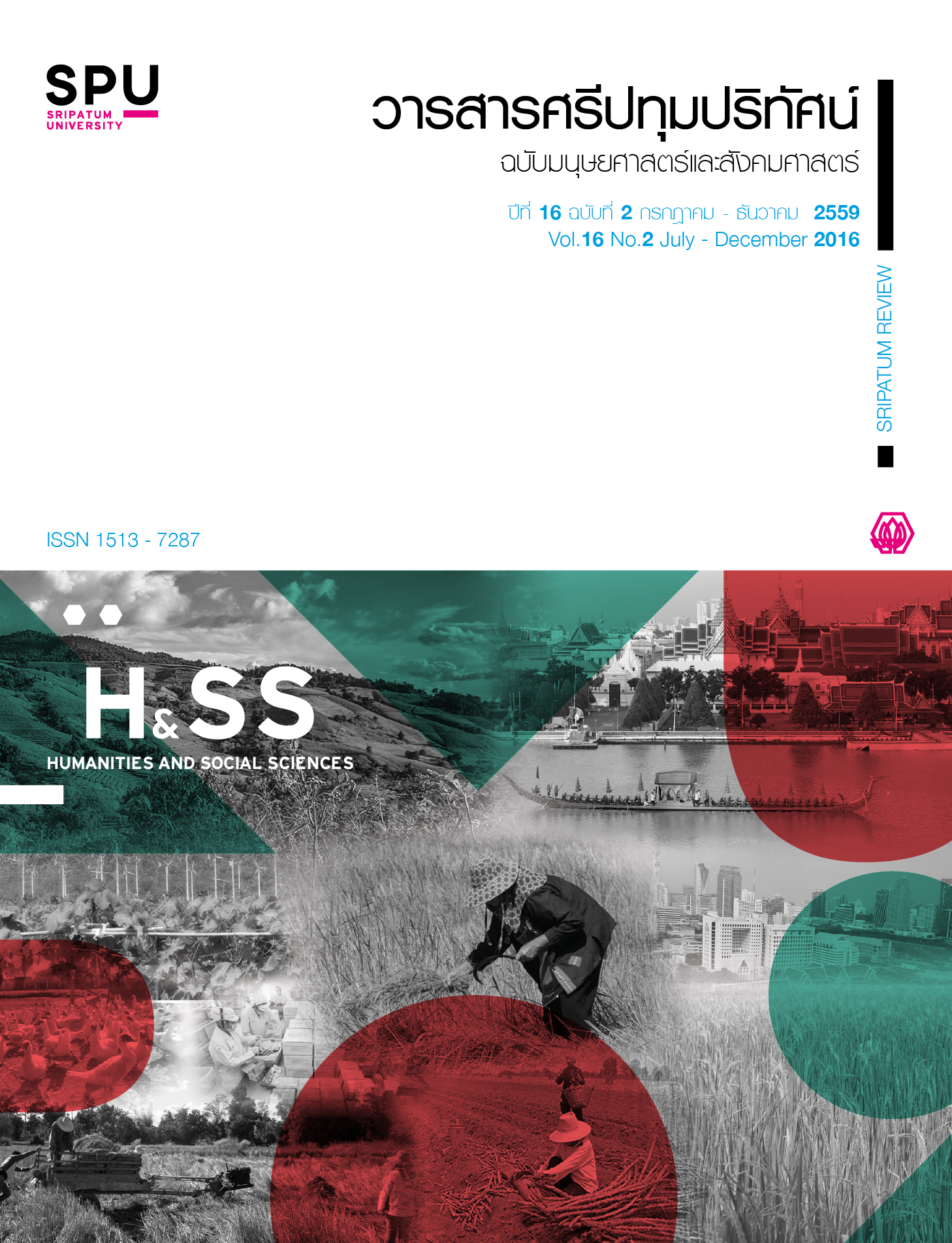THE COMMUNICATION APPROACH TO BUILD TEENAGERS’ PARTICIPATION AND CONSERVATION ON RAMTONE-NOKPHITHID IN NAKHON SI THAMMARAT PROVINCE THROUGH USING VIDEO MEDIA AND ONLINE MEDIA
Main Article Content
Abstract
The objectives of this research were (1) to synthesize information about the origin, pattern and characteristics of Ramtone-Nokphithid dancing; (2) to find out the communication pattern and the way to produce video and online media on Ramtone-Nokphithid dancing for perception and participation of adolescents in Krungching Sub-district, Nopphitam District, Nakhon Si Thammarat Province; and (3) to evaluate the perception and opinions of the audiences. The research process comprised 4 steps: basic information survey step, transferring information step, video production and dissemination step, and evaluation step.
The findings from focus group discussion involving seven local intellectuals and nine adolescents provided the pattern of workshop and video production in cultural documents and video for dancing practice. After that, from synthesis of the focus group discussion contents, document study and non-participatory observation, the findings showed that Ramtone-Nokphithid dancing was a popular folk dance during the period of Field Marshal P. Pibulsonggram as prime minister which was during the World War II. Ramtone or Drum Dancing disseminated from the Central part of Thailand to other parts including the Southern part for entertainment and stress reduction among the military and the people in the time of hardship. This dancing came to Krungching through personal media who saw this dancing from Nakhon Si Thammarat City and adapted the songs and dancing to suit the local taste. These songs were short and diverse and were more than ten in number with corresponding dancing patterns. One unique song was “Nokphithid Dancing” imitating from philandering of a kind of owl, which was funny and joyful. Therefore, this folk dance was called Ramtone-Nokphithid. After video viewing, 71 audiences who were evaluated gained more knowledge about the origin, patterns of dancing and singing. They were also impressed by the video and online media which were appropriate in contents, pictures and sounds. They also had opinions that the media could motivate public participation in Krungching for conserving this folk dance; particularly, the adolescents who could use this media for practicing and dancing in order to conserve this folk culture to always be with Krungching Subdistrict, Nopphitam District, Nakhon Si Thammarat Province.
Article Details
1. กองบรรณาธิการสงวนสิทธิ์ในการพิจารณาและตัดสินการตีพิมพ์บทความในวารสาร
2. บทความทุกเรื่องจะได้รับการตรวจสอบทางวิชาการโดยผู้ทรงคุณวุฒิ แต่ข้อความและเนื้อหาในบทความที่ตีพิมพ์เป็นความรับผิดชอบของผู้เขียนแต่เพียงผู้เดียว มิใช่ความคิดเห็นและความรับผิดชอบของมหาวิทยาลัยศรีปทุม
3. การคัดลอกอ้างอิงต้องดำเนินการตามการปฏิบัติในหมู่นักวิชาการโดยทั่วไป และสอดคล้องกับกฎหมายที่เกี่ยวข้อง
References
คณะกรรมการกลุ่มผลิตชุดวิชาการสร้างสรรค์รายการโทรทัศน์ มหาวิทยาลัยสุโขทัยธรรมาธิราช. 2552.“การสร้างสรรค์รายการโทรทัศน์”.กรุงเทพฯ : มหาวิทยาลัยสุโขทัย-ธรรมาธิราช.
ธนิก เลิศชาญฤทธิ์. 2554. การจัดการทรัพยากรวัฒนธรรม. กรุงเทพฯ: ศูนย์มานุษยวิทยาสิรินธร (องค์การมหาชน).
ปัทมาพร ชเลิศเพ็ชร. 2542. “ซีละ: การละเล่นพื้นเมืองภาคใต้”. สงขลา: โครงการจัดตั้งคณะศิลปกรรมศาสตร์ สถาบัน ราชภัฏสงขลา.
พงษ์ วิเศษสังข์. 2551. ความรู้เบื้องต้นเกี่ยวกับการสื่อสาร. พิมพ์ครั้งที่ 8. กรุงเทพฯ: มหาวิทยาลัยกรุงเทพ.
รักชนกชรินร์ พูลสุวรรณนธี และอาคีรา ราชเวียง. 2556. “การพัฒนาวีดิทัศน์เพื่อการเรียนรู้ด้วยตนเอง เรื่อง ท่ารำมโนราห์เบื้องต้น”. วารสารการประชุมหาดใหญ่วิชาการครั้งที่ 4.
วงหทัย ตันชีวะวงศ์. 2554. การโฆษณาข้ามวัฒนธรรม. กรุงเทพฯ: มหาวิทยาลัยธรรมศาสตร์.
สุทิติ ขัตติยะ. 2552. ศาสตร์การเขียน. กรุงเทพฯ: เปเปอร์ เฮ้าส์.
สุรัตน์ ตรีสุกล. 2550. หลักนิเทศศาสตร์. พิมพ์ครั้งที่ 4. กรุงเทพฯ: ศูนย์หนังสือมหาวิทยาลัยราชภัฏสวนสุนันทา.
องค์การบริหารส่วนตำบลกรุงชิง อำเภอนบพิตำ จังหวัดนครศรีธรรมราช. ม.ป.ป.. แผนพัฒนา 3 ปี พ.ศ. 2555-2557. นครศรีธรรมราช: องค์การบริหารส่วนตำบลกรุงชิง อำเภอนบพิตำ จังหวัดนครศรีธรรมราช.
อาศรมวัฒนธรรม มหาวิทยาลัยวลัยลักษณ์. 2556. “นกพิทิด วัฒนธรรมท้องถิ่นแห่ง กรุงชิง”.
Bloomberg, L., D. 2007. “Culture and community: case study of a video-conferenced graduate distance education program”. Journal of Distance Education Revue de l’education a distance, 22(1): 41-58.


